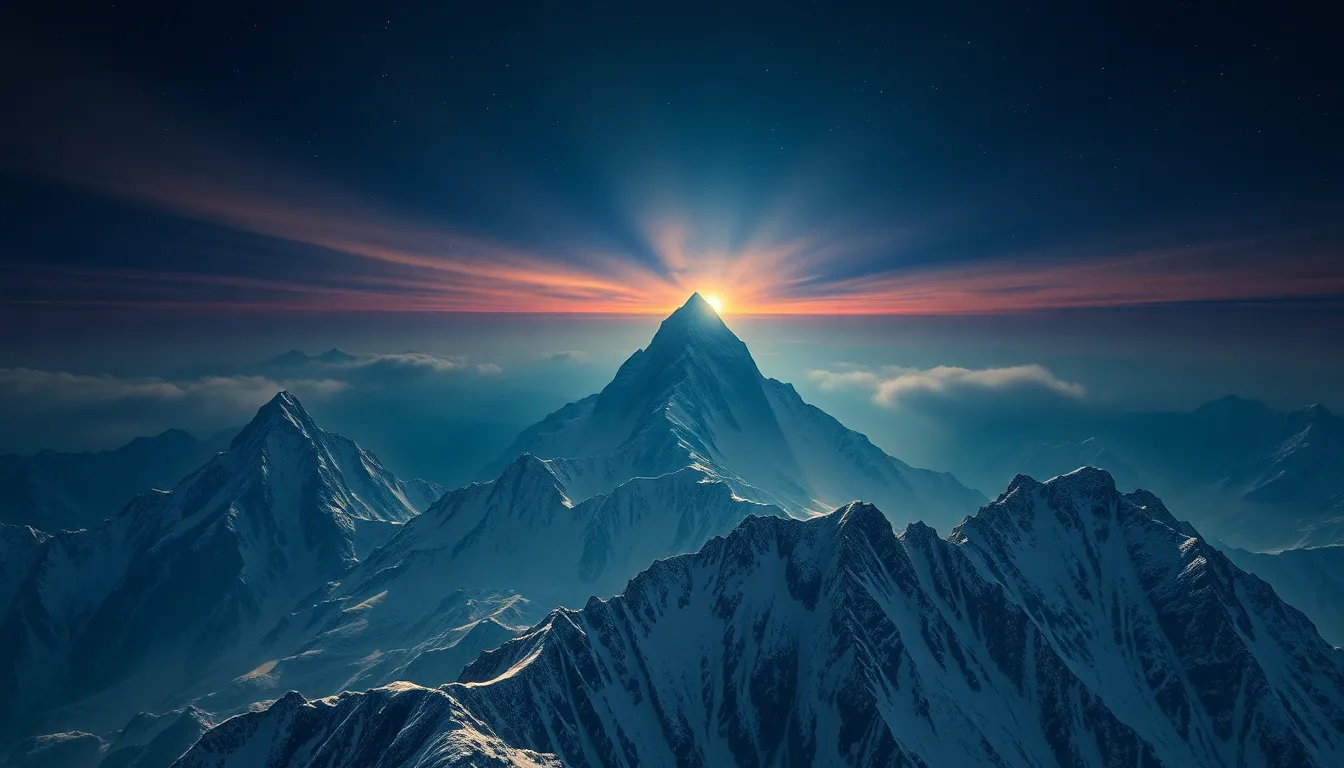The Secrets of the Summit: Unveiling the Mysteries of Mythical Peaks
I. Introduction
Mythical peaks have captivated humanity for centuries, serving as symbols of power, spirituality, and mystery. Defined as mountains that are steeped in folklore and cultural significance, these towering formations often symbolize more than just physical heights; they represent the aspirations, fears, and beliefs of the cultures that revere them. This article aims to explore the legends, mysteries, and allure surrounding these iconic summits, delving into the rich tapestry of global myths and the profound connections people have with these natural wonders.
II. The Allure of Mythical Peaks in Global Cultures
Throughout history, various cultures have woven narratives around mythical mountains, embedding them in their spiritual and historical contexts. These peaks not only serve as backdrops for tales of gods and heroes but also as metaphors for human experiences.
A. Historical context of mythical mountains in various cultures
- Mount Olympus
- Mount Meru
Hailed in Hindu and Buddhist traditions as the axis of the universe, it symbolizes spiritual enlightenment and cosmic order.
- Mount Fuji
A sacred symbol in Japanese culture, Fuji is revered for its beauty and is often associated with artistic expression and spiritual reverence.
In Greek mythology, it is the home of the gods, representing divine authority and the intersection of the mortal and immortal realms.
B. Comparative analysis of peaks in different mythologies
While each peak carries its unique stories, common themes emerge, such as the idea of ascent representing a journey towards enlightenment or divine connection. This comparative analysis reveals how these geographical features are interwoven with cultural identity and spiritual beliefs.
III. The Geology and Geography of Mythical Mountains
The formation of mythical peaks often reflects dynamic geological processes that have occurred over millennia. Understanding these processes provides insight into the natural phenomena that inspire myths.
A. Scientific explanations behind the formation of iconic peaks
- Volcanic activity: Mountains like Fuji and Kilimanjaro originated from volcanic eruptions, shaping their iconic profiles.
- Tectonic movements: The Himalayas, including Mount Meru, were formed from the collision of tectonic plates, showcasing the earth’s dynamic nature.
- Erosion: Many peaks, such as the Alps, have been sculpted by glacial movements, creating dramatic landscapes that inspire myths.
B. Relation between geographical features and mythological narratives
The physical attributes of these mountains often mirror the narratives associated with them, where steep cliffs might symbolize challenges to be overcome, and serene heights signify tranquility and divinity.
IV. Legendary Expeditions and Their Impact on Cultures
Expeditions to mythical peaks have historically been more than mere adventures; they have shaped cultural narratives and inspired generations.
A. Historical accounts of notable expeditions to mythical peaks
- Sir Edmund Hillary and Tenzing Norgay: Their ascent of Mount Everest in 1953 not only marked a significant achievement in mountaineering but also reignited interest in the spiritual significance of the mountain.
- Explorers of Mount Meru: Various expeditions have sought to conquer this sacred peak, each adding layers to its legend.
B. The role of explorers in shaping legends and folklore
Explorers often become part of the myths themselves, with their journeys and experiences contributing to the broader narrative surrounding these peaks, blurring the lines between reality and myth.
V. Mystical Properties and Spiritual Significance
Many mythical peaks are seen as sacred spaces, where the spiritual and physical worlds converge.
A. Examination of the spiritual practices associated with mythical summits
- Pilgrimages: Many cultures organize pilgrimages to these peaks, viewing the journey as a path to enlightenment.
- Rituals: Ceremonies often take place at the foot or summit of these mountains, connecting participants with their spiritual heritage.
B. Stories of enlightenment and transformation linked to ascents
Numerous accounts exist of individuals achieving profound personal transformation after ascending these peaks, reflecting the belief that such journeys can lead to enlightenment and a deeper understanding of oneself.
VI. The Role of Mythical Peaks in Literature and Art
Mythical mountains have inspired countless works of literature and art, serving as powerful symbols in creative expression.
A. Analysis of how these mountains are portrayed in literature and art
- Literary works: From Homer’s epics to modern novels, mythical peaks often symbolize the hero’s journey and the quest for knowledge.
- Artistic representations: Artists have captured the awe-inspiring beauty of these mountains, reflecting their spiritual significance and cultural narratives.
B. Influence of mythical peaks on storytelling and creative expression
The mountains’ grandeur and mystique serve as a backdrop for exploring universal themes of struggle, aspiration, and the quest for understanding, influencing not only individual stories but also the broader narrative of human experience.
VII. Modern-Day Pilgrimages and Tourism
In contemporary society, the allure of mythical peaks has led to a surge in tourism, raising important questions about cultural preservation and environmental sustainability.
A. The rise of tourism to mythical peaks and its implications
- Economic benefits: Tourism can provide significant economic support to local communities.
- Cultural dilution: An influx of tourists may lead to the commercialization of sacred sites, risking the loss of cultural significance.
B. Balancing preservation of cultural significance with tourism demands
Sustainable tourism practices are essential to maintain the spiritual and cultural integrity of these mountains while allowing visitors to experience their beauty and significance.
VIII. Environmental Challenges Facing Mythical Peaks
Mythical peaks are not only cultural treasures but also vital ecosystems facing numerous environmental challenges.
A. Impact of climate change on iconic mountain ecosystems
- Glacial retreat: Many mountains are experiencing significant glacial melt due to rising temperatures, affecting local water sources.
- Flora and fauna shifts: Changing climates are altering the habitats of unique species found in these mountainous regions.
B. Conservation efforts and the importance of protecting these natural wonders
Protecting the ecosystems of mythical peaks is crucial not only for biodiversity but also for preserving the cultural narratives that these mountains inspire. Conservation efforts must integrate local community knowledge with scientific research to ensure sustainable practices.
IX. The Future of Mythical Peaks: Legends and Science Converge
Looking ahead, the intersection of myth and science offers exciting possibilities for understanding and preserving mythical peaks.
A. How technology and scientific research are reshaping our understanding of these summits
- Geological surveys: Advanced technologies allow for more accurate mapping and understanding of geological formations.
- Climate monitoring: Ongoing research helps track the impacts of climate change on these iconic landscapes.
B. The interplay between myth, culture, and modern scientific inquiry
As scientific understanding grows, it can enhance and enrich the cultural narratives surrounding these peaks, offering new insights while respecting traditional beliefs.
X. Conclusion
The enduring allure and mysteries of mythical peaks continue to inspire awe and reverence across cultures. As we explore their legends, geological significance, and the spiritual practices associated with them, it becomes clear that



